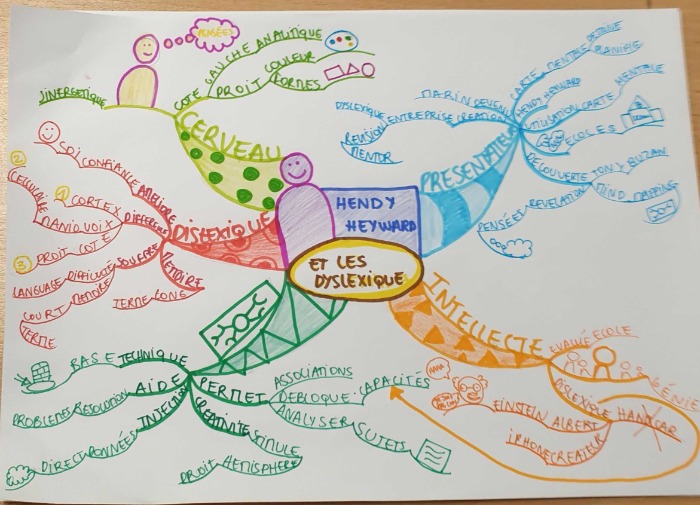A Rising Star of Mind Mapping
Ready for the big time!

Amazing - right?
Central Image - the right size and three colours ...Check!
Clear and distinct Main Branches … Check!
Well-chosen Keywords with words and branches the same length … check!
Ten Images … Check!
Well-defined connecting arrow …. Check!
Yup - as far as the competency of using the Rules of Mind Mapping this competitor has them locked down solid!
What can I suggest?
So what minor tweaks can we suggest for next year's Championship?
Up the Colour
I would make the images mulit-coloured to make them “pop” and make them more memorable. The Images are perfectly executed but allowing them to shine and jump off the page at the reader by making them full colour would make the Mind Map much more memorable.
Upgrade your Tools
I would suggest that this is the time to advance to a finer nibbed pen - making the whole Mind Map a little more refined and elegant and allowing the competitor to demonstrate even more competence by rippling down another level or two.
Finer pens allow you to keep the keywords very clear when you are out towards the periphery of the Mind Map and recording important details. They permit you to write smaller without losing clarity so you can scale the words on your Mind Map from Massive - large - big - medium - small - tiny - minuscule without losing the ability to read them.
Refine Your Main Branches
I would narrow the Main Branches - again they feel a little chunky for the size of the Mind Map and dominate what little negative space there is. Allowing “space” for the Mind Map to “breathe” increases recall and calms a feeling of overwhelm!
Tony Buzan used to call this the “Feng Shui” of Mind Mapping - that it should flow into the space on the paper without overwhelming or congesting the space. Now - this is “World Champion” level coaching BTW - not something that is covered in a normal training session .. but I think this competitor is ready for “World Champion” coaching level - don’t you?
Focus on Central Image
I would practice making a slightly more compelling Central Image - the one here is very competent but I feel this competitor could be truly excellent with just a few tweaks (perhaps even medal-winning excellent).
For preference the Central Image should be a strong visual attention-grabber .. it should be unique and compelling. Our litmus test is “would this stop me in my tracks to look if I was walking past it on a wall” - in this regard I think a little focus before next year’s Championship would really tip this Mind Map over the top!
But even with these minor tweaks - revel in this Mind Map!
Look at the content, the detail, the understanding of this 20-minute talk given by Andy Hayward on the power of the Dyslexic Brain!
These “real-time” Mind Maps are by far the most difficult to master, and to complete this under Championship conditions is wonderful indeed!
I hope this Mind Mapping competitor continues to use Mind Maps - or considers joining us as a coach or part of the “Million Mind Map Challenge” in 2022 .. they are really a rising star showing a great degree of intelligence, competence, and creativity!

This is a very nice, confident Mind Map. The happy faces give it a fun vibe.
I suspect this Mind Map may have been done on A4 paper as it has instances of running out of space. It is always preferable to use A3. If it is on A3 then the main branches need scaling down.
Use of Space
The consequence of lack of space is some branches need to turn back to avoid collision with another branch, or the edge of the page. These sudden changes in direction jar on the eye. You are nicely, smoothly radiating out and then suddenly hit a switchback.
It is very hard to plan space when Mind Mapping a presentation as you never know how much detail you’ll need to add to a section. If I was redrafting this Mind Map, I would reduce the size of the ‘thinking person’ on the top left and move down very slightly. This would allow the remainder of the green branch to flow out to the left, leaving a lot more space for the blue branch to flow into. It would no longer take up a quarter of the page. With the blue branch out of the way the others could be spaced out a tad more. This starts to create the negative space Elaine is talking about.
Tiny Tweaks
Have you heard about the ‘butterfly effect’ in Chaos Theory? It’s what mathematicians call ‘sensitive dependence on initial conditions’. It states that the tiny air disturbance of a butterfly flapping its wings can start a chain reaction leading to a tornado on the opposite side of the world. It’s constantly fascinating how Mind Maps can be affected by a similarly small change. A tiny adjustment like scaling down an image by 20% can impact the whole flow of the Mind Map.
Using the principle of Kaizen – Tiny step by step improvements – It doesn’t take long before you can intuitively feel the best placing of a branch or image.


